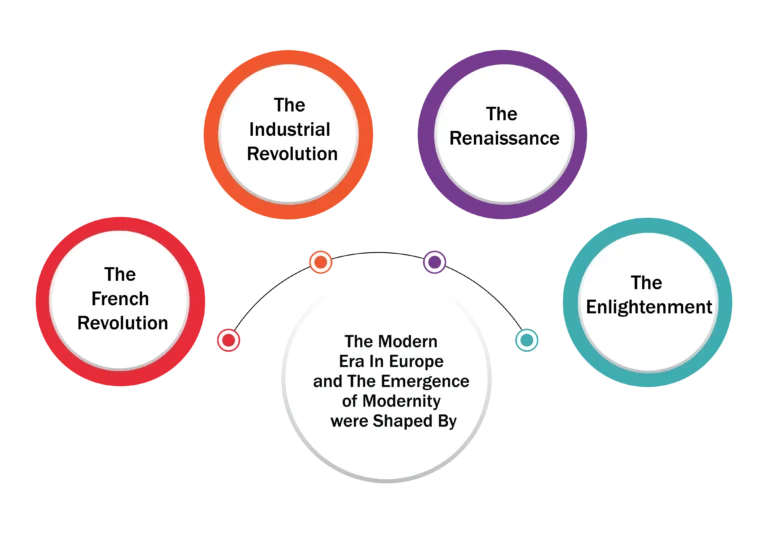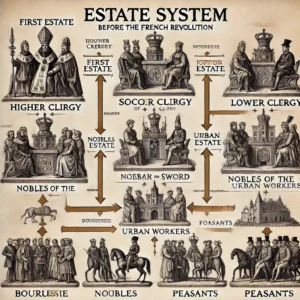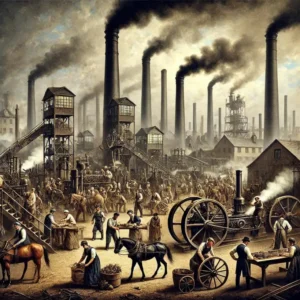Modernity and Social Changes in Europe and Emergence of Sociology
Table of Contents
Modernity refers to a distinct period in human history marked by a shift toward scientific reasoning, as opposed to metaphysical or supernatural beliefs.
It emphasizes individualism, industrialization, technological progress, and the rejection of certain traditional values.
In sociology, modernity describes the era characterized by significant scientific, technological, and socioeconomic transformations, which began in Europe around 1650 and continued until roughly 1950.
The modern era in Europe and the emergence of modernity were shaped by the following key events:

The Renaissance

- The Renaissance was a vibrant period of cultural, artistic, political, and economic revival in Europe, following the Middle Ages.
- Spanning roughly from the 14th to the 17th century, it fostered the rediscovery of classical philosophy, literature, and art.
- This era saw the flourishing of some of the most influential thinkers, writers, statesmen, scientists, and artists in history, while global exploration introduced Europe to new lands and cultures, expanding its commercial horizons.
- The Renaissance is widely recognized for bridging the Middle Ages and the modern world.
Changes during the Renaissance
- Visual Art- Art, literature, and science thrived, with a focus on studying nature and the human body scientifically. Paintings from this time often showcased detailed depictions of both.
- Medicine- Dissecting human bodies became acceptable, allowing doctors to study how the body was built. This led to major progress in anatomy, physiology, and pathology.
- Chemistry – A general theory of chemistry emerged, with studies focusing on chemical processes like oxidation, reduction, distillation, and amalgamation.
- Navigation and Astronomy- This period saw major exploration milestones, with Vasco da Gama reaching India in 1498 and Columbus discovering America in 1492. It was an era of expanding trade and early colonialism. Interest in astronomy also grew, as it played a crucial role in successful navigation.
- The Copernican Revolution – Nicholas Copernicus, a Dutchman, made the first significant break from ancient beliefs. At the time, people believed the Earth was fixed, with the sun and planets revolving around it (the “geocentric” theory). Copernicus challenged this by showing that the Earth actually moves around a fixed sun (the “heliocentric” theory).
Science during the Renaissance adopted a new approach to studying both man and nature. Natural objects were closely observed and experimented on. This period emphasized humanism, modern ideas, and encouraged intellectual growth, rationalism, empiricism, and a focus on change.
The Enlightenment

- The Enlightenment was an intellectual movement, primarily centred in France and Britain, lasting from the 1680s to 1789.
- This period was influenced by earlier writers and scientists like Galileo (Italian), Newton (English), Francis Bacon (English, 1561-1626), and René Descartes (French, 1596-1650), who explored the natural world and systems of thought.
- Key Enlightenment figures include Hobbes, Locke, Diderot, Montesquieu, and Rousseau, with the French writers known as the philosophes.
- These thinkers were often religious sceptics, political reformers, cultural critics, historians, and social theorists.
- Enlightenment writings had a profound impact on politics and the rise of sociology.
- Enlightenment ideas heavily influenced the political and social changes of the time. The revolutionary slogans “liberty, equality, fraternity” and “life, liberty, and the pursuit of happiness” reflect the political ideals rooted in Enlightenment thought.
In the 18th century, Europe entered the Age of Reason and Rationalism, influenced by major philosophers like Montesquieu, Locke, Voltaire, Rousseau, Adam Smith, and John Stuart Mill.
- Montesquieu: In his book “The Spirit of the Laws”, he argued against concentrating power in one place and advocated for the “separation of powers” among the executive, legislative, and judicial branches to protect individual liberty.
- John Locke: This English philosopher believed every person has certain “inalienable rights”, including the right to life, property, and personal freedom. He argued that rulers who violate these rights should be removed and replaced by those who protect them.
- Voltaire: A French philosopher, Voltaire championed “religious tolerance” and “freedom of speech”, emphasizing individual rights and expression.
- Jean-Jacques Rousseau: In “The Social Contract”, Rousseau stated that people have the right to choose their government. He believed individuals can best develop their personalities under a government of their own choosing.
- Mary Wollstonecraft: She was an English author and feminist, best known for her influential book, “A Vindication of the Rights of Woman” (1792), embraced the idea of the “rational, self-determining individual”. She argued that women are not naturally different from men; rather, the differences arise from “socially constructed gender roles”. She believed that women, like men, are rational beings and deserve equal opportunities to develop their reasoning and moral skills.
This period marked a significant change in people’s thinking, leading society to adopt a more pragmatic approach
Changes during the Enlightenment in Europe:
- Promotion of Reason: Emphasized reason and scientific thinking over tradition and superstition.
- Human Rights: Advocated for individual rights and freedoms, influencing modern human rights movements.
- Political Change: Inspired revolutions, such as the American and French Revolutions, leading to the decline of monarchies and the rise of democratic governments.
- Secularism: Reduced the power of religious institutions and promoted secular governance.
- Social Reform: Encouraged social changes, including the abolition of slavery and the push for gender equality.
- Educational Expansion: Increased emphasis on education and literacy, leading to the establishment of public education systems.
- Cultural Development: Influenced art, literature, and philosophy, fostering a culture of critical thinking and debate.
- Scientific Advancements: Laid the groundwork for modern scientific inquiry and innovation.
These results significantly shaped modern European society and thought.
The French Revolution

- The French Revolution (1789-1799) was a period of profound social, political, and economic upheaval in France.
- It marked the end of absolute monarchy, the rise of republicanism, and the establishment of democratic ideals.
- Characterized by radical changes, the revolution sought to eliminate the inequalities of the feudal system and promote the principles of liberty, equality, and fraternity.
Causes of the French Revolution
- Social Inequality: French society was divided into three estates:

- First Estate: Clergy, enjoying privileges and exemptions from taxes.
- Second Estate: Nobility, who held significant power and wealth.
- Third Estate: Common people, including peasants and the bourgeoisie, who bore the burden of taxation without political representation.
- Economic Hardship: France faced severe financial problems due to:
- Debt from wars, including involvement in the American Revolution.
- Poor harvests leading to food shortages and rising bread prices.
- High taxation on the Third Estate, leading to widespread discontent.
- Enlightenment Ideas: Enlightenment thinkers such as Rousseau, Voltaire, and Montesquieu promoted ideas of democracy, individual rights, and social contracts, challenging traditional authority and inspiring revolutionary thought.
- Weak Leadership: King Louis XVI’s indecisiveness and inability to resolve financial crises weakened the monarchy’s authority and credibility.
- Estates-General: The convening of the Estates-General in 1789 to address the financial crisis led to demands for more political representation, ultimately igniting revolutionary fervor.
Changes during the French Revolution
- End of Monarchy: The revolution led to the execution of King Louis XVI in 1793 and the establishment of the First French Republic.
- Rise of Radicalism: The revolution saw the emergence of radical factions, such as the Jacobins, and the Reign of Terror, during which thousands were executed, including political opponents.
- Social Changes: The feudal system was abolished, and various social reforms were implemented, including the Declaration of the Rights of Man and of the Citizen, which emphasized individual rights and equality.
- Rise of Napoleon: The chaos following the revolution paved the way for Napoleon Bonaparte’s rise to power, leading to the establishment of the Napoleonic Empire.
- Influence on Other Revolutions: The French Revolution inspired other movements for change around the world, promoting ideas of democracy, nationalism, and human rights.
French Revolution was a pivotal event that reshaped France and had lasting impacts on the world, establishing principles that continue to influence modern democratic societies.
The Industrial Revolution

The Industrial Revolution began around 1760 AD in England and marked the foundation of modern industry. Spanning the late 18th and early 19th centuries, it brought significant material and social changes, primarily through the rise of industrialization and capitalism.
This period saw the birth of the factory system, which transformed production methods, led to the emergence of a middle class, and dismantled the feudal estates. While these developments resulted in various positive outcomes, such as increased productivity and economic growth, they also brought about numerous negative consequences.
In Europe, particularly in England, the discovery of new territories and the growth of trade and commerce led to an increased demand for goods. Previously, consumer items like cloth were produced through a domestic system, meaning they were made at home. However, with the rising demand, there was a need for large-scale production.
This shift brought significant changes to the social and economic lives of people, starting in England and eventually spreading to other European countries and later to other continents.
Changes during the Industrial Revolution:
- Labor Conditions: A new working class emerged, reliant on factory jobs, often living in poverty and harsh conditions. This social deprivation made them a significant social force.
- Recognition of Poverty: Sociologists identified the poverty faced by these workers as a result of social structures rather than being a natural condition, making the working class a focal point of moral and analytical concern in the 19th century.
- Property Transformation: Capital became crucial during the Industrial Revolution, with investments in the new industrial system gaining recognition. The influence of feudal landlords waned as new capitalists, many of whom were former landlords, rose to power.
- Urbanization: This period saw rapid urbanization, which was accompanied by increasing poverty and rising crime rates.
- Technological Advancements: Innovations in technology led to the development of the factory system.
- Social Condition Surveys: Increased interest in assessing social conditions through systematic surveys.
- Nuclear Family Emergence: The traditional family structure shifted towards the emergence of the nuclear family.
- Colonialism: The Industrial Revolution fuelled the expansion of colonialism as nations sought resources and markets for their industrial products.
Conservationist’s reaction to modernity
- The most extreme form of opposition to modernity was from French catholic counter-revolutionary philosophy as represented by the ideas of Louis de bonald and Joseph de Maistre.
- They saw these developments as disturbing characters to the peace and harmony of the society. They believed God had created society; people shouldn’t tamper with it and try to change the holy creation.
- Bonald opposed anything that undermined traditional institutions such as patriarchy, the Monarchy, the monogamous family and the Church. Believed religion as a useful and necessary component of social life.
- They saw French Revolution and Industrial revolution as disruptive forces. The conservatives tend to emphasize on old social order. Changes were seen as a threat not only to society and its components, but also to the individuals in it.
- They saw modern changes such as industrialization, urbanization and bureaucratization as causing disorganizing effects. These changes were viewed with fear and anxiety. Finally, conservatives supported the existence of a hierarchical system in the society.
Critical analysis of modernity
- Modernity is form of ideas, kind of perceptions and pattern of beliefs. Those who fall in love with modernity celebrate it; those people can’t adapt to changes feel as victim and criticize it.
- Modernity brings political unity and economic freedom. All philosophers and rational thinkers celebrated modernity for its achievements.
- Emile Durkheim stated that every society which changed from agrarian to industrial economy had its own problems. An anomie will be created in the society and it must be rectified by society itself.
- Karl Marx welcomes the change in society, but he accused that the fruits of modernity and its outcomes were enjoyed by one class and made other class to suffer.
- Augustus Comte, father of sociology believed in scientific study of social pattern, that is positivism. By using this positivism, he believed society can repair its problems.
- Max Weber also believed that, by using standard scientific methods, the scepticism of modernity can be cleaned out. Modernity is now a fully grown man. It can’t be turned as child. But we can cure the problems of society through the methods of sociology.
How these Social Changes led to emergence of Sociology?

- Modernity significantly affected the social, economic, and political lives of people. Initially viewed positively, its negative consequences soon became evident.
- Social Dislocation: Rapid urbanization led to the breakdown of traditional communities and social structures.
- Inequality: Economic changes resulted in stark disparities between different social classes, particularly between the wealthy elite and the working class.
- Environmental Degradation: Industrialization contributed to pollution, deforestation, and depletion of natural resources.
- Alienation: Individuals often felt disconnected from their work, society, and even themselves, as factory work became repetitive and dehumanizing.
- Consumerism: A focus on material goods fostered a culture of consumerism, leading to overconsumption and waste.
- Loss of Cultural Heritage: Traditional practices and values were often disregarded or lost in the pursuit of modernization and progress.
- Mental Health Issues: Increased stress and anxiety levels arose from rapid societal changes and the pressures of modern life.
- Political Instability: Modernity often led to upheaval, revolutions, and conflicts as groups struggled for power and rights.
- Exploitation of Labor: The emergence of factories often resulted in poor working conditions, long hours, and exploitation of workers, including children.
- Erosion of Community Bonds: A focus on individualism weakened communal ties and social solidarity, leading to isolation through Divorce and Breakups.
- These challenges posed by modernity spurred the development of new intellectual ideas.
- Existing disciplines were unable to address the emerging questions, leading to the creation of a new field known as sociology.
- Arising from its specific context, sociology was often referred to as the “science of the new industrial society.”
- While there was a general context for sociology’s emergence across Europe, France provided a unique socio-political backdrop, particularly influenced by the upheaval caused by the French Revolution.
- Intellectuals like Saint Simon, Auguste Comte, Herbert Spencer, and Émile Durkheim contributed foundational ideas to the discipline, seeking to understand the causes and consequences of these new societal changes.
- Simon initially referred to this field as social physics, while Comte was the first to coin the term sociology.
- Following Comte’s lead, Spencer introduced the concept of “social evolution,” akin to biological evolution.
- Durkheim’s efforts were instrumental in establishing sociology as the first academic department in France and Europe, solidifying its distinct status.
- This emerging discipline required a subject matter, data, perspectives, and methods. Influenced by the popularity of the natural sciences, sociology explored new scientific and rational methods.
- The “State of the Poor” report marked the first scientific survey in Europe, revealing that poverty is a social, rather than a natural, phenomenon.
The factual foundation for sociology was supported by existing historical records, while early theoretical perspectives were shaped by Comte, Spencer, and Durkheim. Hence Sociology emerged as a discipline to address the profound changes in the Society.
Previous Year Questions
- How had Enlightenment contributed to the emergence of Sociology? (2015)
- Discuss the historical antecedents of the emergence of Sociology as a discipline (2019)
- How did the intellectual forces lead to the emergence of Sociology? Discuss (2020)
- Europe was the first and the only place where modernity emerged. Comment (2021)
- What aspects of Enlightenment do you think paved way for the emergence of Sociology? Elaborate (2022)
- Sociology is the product of European Enlightenment and Renaissance. Critically examine this statement. (2024)
Important Keywords
Modernity, The Renaissance, The Enlightenment, The French Revolution, The Industrial Revolution, Urbanization, Emergence of Sociology, Saint Simon, Auguste Comte, Herbert Spencer, and Émile Durkheim, Social Changes, Monarchy, Vasco da Gama, Columbus, Louis de bonald, Joseph de Maistre and Individualism.


